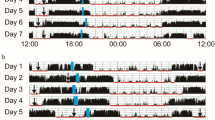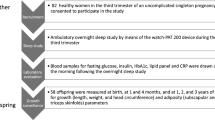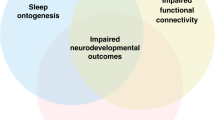Abstract
Objective:
The current study examined the relationship between sleep state development across the preterm and early post-term periods and subsequent growth trajectories from 1 to 27 months corrected age.
Study design:
Retrospective analysis of data collected prospectively from 111 preterm infants (⩽34 weeks gestation) who participated in a multi-site longitudinal study. Separate longitudinal parallel process models were calculated for each sleep state (active and quiet sleep) and growth (weight, length and body mass index (BMI) Z-scores) variable to estimate the associations between their developmental trajectories.
Results:
Significant associations were identified between the trajectories of quiet sleep and weight, active sleep and weight, quiet sleep and BMI, and active sleep and BMI. No statistically meaningful associations were identified between the trajectories of early childhood length and the preterm sleep states.
Conclusion:
Faster preterm period sleep development appears to predict more favorable early childhood growth trajectories, particularly for weight, indicating preterm sleep may be an important biomarker for subsequent growth outcomes.
This is a preview of subscription content, access via your institution
Access options
Subscribe to this journal
Receive 12 print issues and online access
$259.00 per year
only $21.58 per issue
Buy this article
- Purchase on Springer Link
- Instant access to full article PDF
Prices may be subject to local taxes which are calculated during checkout



Similar content being viewed by others
References
Committee on Understanding Premature Birth and Assurring Healthy Outcomes, Preterm Birth: Causes, Consequences, and Prevention. National Academies Press: Washington, DC, USA, 2007.
Woods N, Costeloe K, Gibson AT, Hennessy EM, Marlow N, Wilkinson AR et al. The EPICure study: growth and associated problems in children born at 25 weeks gestational age or less. Arch Dis Child Fetal Neonatal Ed 2003; 88: F492–F500.
Ford GW, Doyle LW, Davis NM, Callanan C . Very low birth weight and growth into adolescence. Arch Pediatr Adolesc Med 2000; 154: 778–784.
Uthaya S, Thomas EL, Hamilton G, Dore GJ, Bell J, Modi N . Altered adiposity after extremely preterm birth. Pediatr Res 2005; 57: 211–215.
Rotteveel J, van Welssenbruch MM, Twisk JWR, Delemarre-Van de Waal HA . Infant and childhood growth patterns, insulin sensitivity, and blood pressure in prematurely born young adults. Pediatrics 2008; 122: 313–321.
Willemsen RH, de Kort SWK, van der Kaay DCM, Hokken-Koelega ACS . Independent effects of prematurity on metabolic and cardiovascular risk factors in short small-for-gestataional-age children. J Clin Endocrinol Metab 2008; 93: 452–458.
Gaskins RB, LaGasse LL, Liu J . Small for gestational age and higher birth weight predict childhood obesity in preterm infants. Am J Perinatol 2010; 27: 721–730.
Euser AM, Finken MJJ, Keijzer-Veen MG, Hille ET, Wit JM, Dekker FW et al. Associations between prenatal and infancy weight gain and BMI, fat mass, and fat distribution in young adulthood: a prospective cohort study in males and females born very preterm. Am J Clin Nutr 2005; 81: 480–487.
Ong KK, Kennedy K, Castaneda-Guitierrez E, Forsyth S, Godfrey KM, Koletzko B et al. Postnatal growth in preterm infants and later health outcomes: a systematic review. Acta Paediatr 2015; 104: 974–986.
Belfort MB, Rifas-Shiman SL, Sullivan T, Collins CT, McPhee AJ, Ryan P et al. Infant growth before and after term: effects on neurodevelopment in preterm infants. Pediatrics 2011; 128: e899–e906.
Leproult R, Van Cauter E . Role of sleep and sleep loss in hormonal release and metabolism. Endocr Dev 2010; 17: 11–21.
Bonuck K, Chervin RD, Howe LD . Sleep-disordered breathing, sleep duration, and childhood overweight: a longitudinal cohort study. J Pediatr 2015; 166: 632–639.
Cespedes EM, Rifas-Shiman SL, Redline S, Gillman MW, Pena MM, Taveras EM . Longitudinal associations of sleep curtailment with metabolic risk in mid-childhood. Obesity 2014; 22: 2586–2592.
Bell JF, Zimmerman FJ . Shortened nighttime sleep duration in early life and subsequent childhood obesity. Arch Pediatr Adolesc Med 2010; 164: 840–845.
Cappuccio FP, Taggart FM, Kandala N, Currie A, Peile E, Stranges S et al. Meta-analysis of short sleep duration and obesity in children and adults. Sleep 2008; 31: 619–626.
Taveras EM, Rifas-Shiman SL, Oken E, Gunderson EP, Gillman MW . Short sleep duration in infancy and risk of childhood overweight. Arch Pediatr Adolesc Med 2008; 162: 305–311.
Tikotzky L, De Marcas G, Har-Toov J, Dollberg S, Bar-Haim Y, Sadeh A . Sleep and physical growth in infants during the first 6 months. J Sleep Res 2010; 19: 103–110.
Klingenberg L, Christensen LB, Hjorth MF, Zangenberg S, Chaput JP, Sjödin A et al. No relation between sleep duration and adiposity indicators in 9-36 months old children: the SKOT cohort. Pediatr Obes 2013; 8: e14–e18.
Holditch-Davis D, Scher M, Schwartz T, Hudson-Barr D . Sleeping and waking state development in preterm infants. Early Human Dev 2004; 80: 43–64.
Peirano P, Algarin C, Uauy R . Sleep-wake states and their regulatory mechanisms throughout early human development. J Pediatr 2003; 143: S70–S79.
Scher MS, Steppe DA, Banks DL . Lower neurodevelopmental performance at 2 years in preterm neonates. Pediatr Neuro 1994; 11: 121–122.
Holditch-Davis D, Belyea M, Edwards LJ . Prediction of 3-year developmental outcomes from sleep development over the preterm period. Infant Behav Dev 2005; 28: 118–131.
Sung M, Adamson TM, Horne SC . Validation of actigraphy for determining sleep and wake in preterm infants. Acta Paediatr 2009; 98: 52–57.
Sahni R, Schulze KF, Stefanski M, Myers MM, Fifer WP . Methodological issues in coding sleep states in immature infants. Dev Psychobiol 1995; 28: 85–101.
World Health Organization, The WHO child growth standards [Internet]. World Health Organization: Geneva, Switzerland, 2016 [cited 1 Sep 2016]. Available at: http://www.who.int/childgrowth/standards/en/.
de Onis M, Garza C, Onyango AW, Rolland-Cachera MF . WHO growth standards for infants and young children. Arch Pediatr 2009; 16: 47–53.
Cheong J, MacKinnon DP, Khoo ST . Investigation of mediational processes using parallel process latent growth curve modeling. Struct Equ Modeling 2003; 10: 238–262.
Sousa KH, Kwok OM, Schmiege SJ, West SG . A longitudinal approach to understanding the relationship between symptom status and QOL. Western J Nurs Res 2014; 36: 732–747.
Knafl GJ, Beeber L, Schwartz T . A strategy for selecting among alternative models for continuous longitudinal data. Res Nurs Health 2012; 35: 647–658.
Ong KKL, Ahmed ML, Emmett PM, Preece MA, Dunger DB, the ALSPAC team. Association between postnatal catch-up growth and obesity in childhood: prospective cohort study. BMJ 2000; 320: 967–971.
Cameron N, Pettifor J, De Wet T, Norris S . The relationship of rapid weight gain in infancy to obesity and skeletal maturity in childhood. Obes Res 2003; 11: 457–460.
Monteiro POA, Victora CG, Barros FC, Monteiro LMA . Birth size, early childhood growth, and adolescent obesity in a Brazilian birth cohort. Int J Obes 2003; 27: 1274–1282.
Palagini L, Drake C, Gehrman P, Meerlo P, Riemann D . Early-life origin of adult insomnia: does prenatal-early-life stress play a role? Sleep Med 2015; 16: 446–456.
Maurer N, Perkinson-Gloor N, Stalder T, Hagmann-von Arx P, Brand S, Holsboer-Trachsler E et al. Salivary and hair glucocorticoids and sleep in very preterm children during school age. Psychoneuroendocrinology 2016; 72: 166–174.
Chamorro R, Algarin C, Garrido M, Causa L, Held C, Lozoff B et al. Night time sleep macrostructure is altered in otherwise healthy 10-year-old overweight children. Int J Obes 2014; 38: 1120–1125.
Kahn A, Mozin MJ, Rebuffat E, Sottiaux M, Burniat W, Shepherd S et al. Sleep pattern alterations and brief airway obstructions in overweight infants. Sleep 1989; 12: 430–438.
Brandon DH, Holditch-Davis D, Beylea M . Nursing care and the development of sleeping and waking behaviors in preterm infants. Res Nurs Health 1999; 22: 217–229.
Brazy JE, Goldstein RF, Oehler JM, Gustafson KE, Thompsone RJ . Nursery neurobiologic risk score: levels of risk and relationships with nonmedical factors. Dev Behav Pediatr 1993; 14: 375–380.
Acknowledgements
This work was supported by the National Institute of Nursing Research of the National Institutes of Health (grant numbers F31NR014960, NR01894).
Author information
Authors and Affiliations
Corresponding author
Ethics declarations
Competing interests
The authors declare no conflict of interest.
Additional information
Supplementary Information accompanies the paper on the Journal of Perinatology website
Supplementary information
Rights and permissions
About this article
Cite this article
Winkler, M., Park, J., Pan, W. et al. Does preterm period sleep development predict early childhood growth trajectories?. J Perinatol 37, 1047–1052 (2017). https://doi.org/10.1038/jp.2017.91
Received:
Revised:
Accepted:
Published:
Issue Date:
DOI: https://doi.org/10.1038/jp.2017.91



